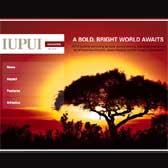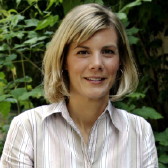|
|
 |

The Fall 2010 issue of IUPUI Magazine focuses on the theme "A Bold, Bright World Awaits." Read the online version of the magazine to discover what IUPUI students are doing that leads to career-changing and life-changing opportunities.
|
|
|
 |

The historic Kirkwood Observatory on the IU Bloomington campus will be open one last time this year for tours and stargazing (Nov. 17, 6:30-8:30 pm). See Events below for more information. The observatory was completed in 1900, and extensively renovated in 2001. It is named for IU astronomer Daniel Kirkwood, whose name is associated with the gaps in the Asteroid Belt he discovered, as well as the road west of campus, which he also discovered at some point, presumably.
|
|
|
 |
"Between Invention and Experiment: Mechanical Arts in Francis Bacon"
Thursday, Nov. 19
4-6 p.m.
Ballantine 003, IU Bloomington
History and Philosophy of Science Professor Cesare Pastorino questions the view that Francis Bacon's understanding of mechanical arts was purely theoretical, philosophical, and "literary," and that his links with artisans and craftsmen of his time were negligible or nonexistent. He will discuss Bacon's institutional involvement in the early Stuart patent system, and his concrete contacts with entrepreneurs, projectors, and inventors. For more information, please e-mail parobert@indiana.edu.
|
 |
 |
|
Scientist at Work: Jill Robinson

 Since arriving in Bloomington eight years ago, Indiana University chemist Jill Robinson has been faced with the challenge of adapting to a large student population and ever-quickening electronic communication, and developing an effective teaching method for the modern classroom. With larger class sizes, Robinson is unable to engage every student individually, and likens her educator's role as akin to directing air traffic in a control tower. Robinson says she makes an effort to be available to students, however. She frequently visits lab sections to see how her students are doing and is often seen helping out students in need long after lecture has let out.
Full Story
Since arriving in Bloomington eight years ago, Indiana University chemist Jill Robinson has been faced with the challenge of adapting to a large student population and ever-quickening electronic communication, and developing an effective teaching method for the modern classroom. With larger class sizes, Robinson is unable to engage every student individually, and likens her educator's role as akin to directing air traffic in a control tower. Robinson says she makes an effort to be available to students, however. She frequently visits lab sections to see how her students are doing and is often seen helping out students in need long after lecture has let out.
Full Story
|

Indiana University medical scientists will receive $900,000 from the Ovarian Cancer Research Fund, or OCRF, to help them prepare the new drug SGI-110 for clinical trials in patients whose once-thwarted ovarian cancer has returned. Medical Sciences Program-Bloomington cancer biologist Kenneth Nephew is leading the project in collaboration with co-investigators Daniela Matei and John Turchi of the IU Melvin and Bren Simon Cancer Center in Indianapolis.
Full Story

The National Science Foundation has allotted $1.1 million in funding to two Indiana University-led research projects in environmental science. According to the NSF, the foundation is funding seven awards under its Environment, Society and Economics (ESE) umbrella to foster collaboration among geoscientists and social scientists to address crucial issues for the environment, society and the economy -- and how the three affect each other. The awards will factor valuation of "ecosystem services" into economic activities in a way that provides critically important information about land and water use.
Full Story

Sossina Haile knows the heat of the sun can be used to convert water and carbon dioxide into energy that can be stored in a fuel cell. She's such a believer in the technology that she once brought her point home by drinking, on camera, the tailpipe emissions from a fuel-cell car. Haile brought her Fulbright and Humboldt Scholar award-winning messages about sustainable energy to Indiana University Bloomington's Whittenberger Auditorium for a recent public lecture.
Full Story

The distance between Northeast Indiana and Northwest Argentina may not be as far as you think. The link that ties these two locations together is Aranzazu Pinan-Llamas, assistant professor of geology at Indiana University-Purdue University Fort Wayne. Pinan-Llamas' interest and research in structural geology and tectonics has taken her to Argentina several times over the last seven years. It has also taken her to Denver, Col., where she presented her research to 6,000 fellow scientists at the Geological Society of America 2010 Annual Meeting and Exposition.
Full Story

A new study by Kinsey Institute researchers examines to what degree compulsive sexual behavior, sometimes called "sex addiction," is influenced by learning processes and other aspects of a person's environment. Erick Janssen and his collaborators are finding that the development of compulsive behavior and the consumption of alcohol can act as catalysts in sexual risk-taking. Their ongoing study, "The role of conditioning and alcohol in compulsivity and risk taking," is the first to test various aspects of sexual compulsivity in a laboratory.
Full Story

Technologies for rapid detection of bacterial pathogens are crucial to maintaining a secure food supply. Researchers from the School of Science at Indiana University-Purdue University Indianapolis (IUPUI) and the Bindley Bioscience Center at Purdue University have developed a novel approach to automated detection and classification of harmful bacteria in food. The investigators have designed and implemented a sophisticated statistical approach that allows computers to improve their ability to detect the presence of bacterial contamination in tested samples. These formulas propel machine-learning, enabling the identification of known and unknown classes of food pathogens.
Full Story

The October 19, 2010, issue of IU Discoveries featured chemist Dennis Peters and the development of his scientific career. Also included were stories about the use of an antibiotic to combat Huntington's disease, new risks associated with chemotherapy, a device that could help thwart a deadly birth defect, the detoxification of Hungary's red sludge, a new IUPUI initiative to expand science and technology talent, and a study that has found genetically modified corn products have seeped -- albeit at low concentrations -- into the Indiana environment.
Full Story
 |
 |
|
|
 |
Some recent titles by IU researchers
"Nanophysics in graphene: neutrino physics in quantum rings and superlattices," Philosophical Transactions Series A, Dec. 13, 2010, by H.A. Fertig and L. Brey
"A simple strategy for the construction of combinatorial cyclic peptoid libraries," Chemical Communications, Dec. 7, 2010, by J.H. Lee, A.M. Meyer, and H.S. Lim
"Altered cytokine production by dendritic cells from infants with atopic dermatitis," Clinical Immunology, Dec. 2010, by W. Yao, J. Chang, S. Sehra, J.B. Travers, C.H. Chang, R.S. Tepper, and M.H. Kaplan
"Genetic Variants in the 53BP1 Gene and Skin Cancer Risk," Genetic Variants in the 53BP1 Gene and Skin Cancer Risk, Dec. 2010, by C. He, H. Nan, A.A. Quershi. and J. Han
|
|
|
 |
|
|
|
 |
 The Indiana University Kokomo community and beyond can now tune in and listen to their favorite songs on Radio Free Kokomo, a 24-hour online streaming radio station organized and produced by students on campus. Listeners can tune in by clicking on a streaming link.
The Indiana University Kokomo community and beyond can now tune in and listen to their favorite songs on Radio Free Kokomo, a 24-hour online streaming radio station organized and produced by students on campus. Listeners can tune in by clicking on a streaming link.
|
|







